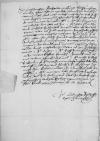Ich hab nicht mocht noch lossen, / Ew(e)r F(urstlichen) D(urchlauch)t mit dissem meynem(m) schreib(e)n zu besuchen / und do mit meiner zu gedencken E(wer) D(urchlauch)t zu erinneren, nemlich in dem, das ich hie E(wer) D(urchlauch)t gern(n) fruntlich und nuczlich heth wold dinen(n), / wie ich dan ouch etwan, wor es stelle und zceit hot gehabt, / gethon(n), ouch was mir muglich noch gern thun wil. / Es sein aber hie solche hendel vorhanden(n), / die wunderlich zu ghen. / Muss mich derweg(en) ouch in gemeynen des Royal Prussia (Prussia Regalis), region, part of Prussia annexed to the Kingdom of Poland in 1466 under the provisions of the Second Peace of Thorn⌊landsRoyal Prussia (Prussia Regalis), region, part of Prussia annexed to the Kingdom of Poland in 1466 under the provisions of the Second Peace of Thorn⌋ und meinen(n) eigenen sachen viler dinge enthalden(n) etc. Wie es hie zugheth, wirt E(wer) D(urchlauch)t disser E(wer) D(urchlauch)t hoff diner, Felix von Allen (Felix von Alden, Feliks Mełdzyński, Felix Stang, Felix von Malden) (†ca. 1576), Prussian nobleman in the service of Duke Albrecht von Hohenzollern; 1529, 1530, 1533, 1536, 1538 ducal envoy to King Sigismund I Jagiellon and, in 1537, to the Crown Diet at Piotrków; 1545-1551(?) Vice-Voivode of Kulm (Chełmno); 1551 alderman of Kulm; 1551-1575 Sword-Bearer of Kulm (SZYMANIAK 1992, p. 55-56; Urzędnicy 5/2, p. 221)⌊Felix von(n) Alten(n)Felix von Allen (Felix von Alden, Feliks Mełdzyński, Felix Stang, Felix von Malden) (†ca. 1576), Prussian nobleman in the service of Duke Albrecht von Hohenzollern; 1529, 1530, 1533, 1536, 1538 ducal envoy to King Sigismund I Jagiellon and, in 1537, to the Crown Diet at Piotrków; 1545-1551(?) Vice-Voivode of Kulm (Chełmno); 1551 alderman of Kulm; 1551-1575 Sword-Bearer of Kulm (SZYMANIAK 1992, p. 55-56; Urzędnicy 5/2, p. 221)⌋, weitlofftig bericht(en). / Hirum(m)b wil ich mit vilem schreiben(n) dis mol E(wer) D(urchlauch)t nicht belast(en) bittend, E(wer) F(urstliche) D(urchlauch)t wolde mein hochgunstig(e)r, liber her und freundt sein und bleib(e)n, / in der gunst ich mich thue befelen(n). Got der almechtig gebe derselbt(e)n E(wer) D(urchlauch)t mit irer lib(e)n Dorothea von Oldenburg (*1504 – †1547), Duchess in Prussia (1526-1547); first wife of Albrecht I von Hohenzollern-Ansbach, Duke in Prussia, daughter of Frederic I von Gottorp, King of Denmark, and Anna von Hohenzollern⌊furstinDorothea von Oldenburg (*1504 – †1547), Duchess in Prussia (1526-1547); first wife of Albrecht I von Hohenzollern-Ansbach, Duke in Prussia, daughter of Frederic I von Gottorp, King of Denmark, and Anna von Hohenzollern⌋ und geslecht alles, das zur selen und leib / in langweriger gesuntheit und glukselig(en) regiment / gut ist.
 GStA, PK, HBA, C 2, No 114, 2 unnumbered
GStA, PK, HBA, C 2, No 114, 2 unnumbered  GStA, PK, HBA, C 2, No 114, 1 unnumbered
GStA, PK, HBA, C 2, No 114, 1 unnumbered 
